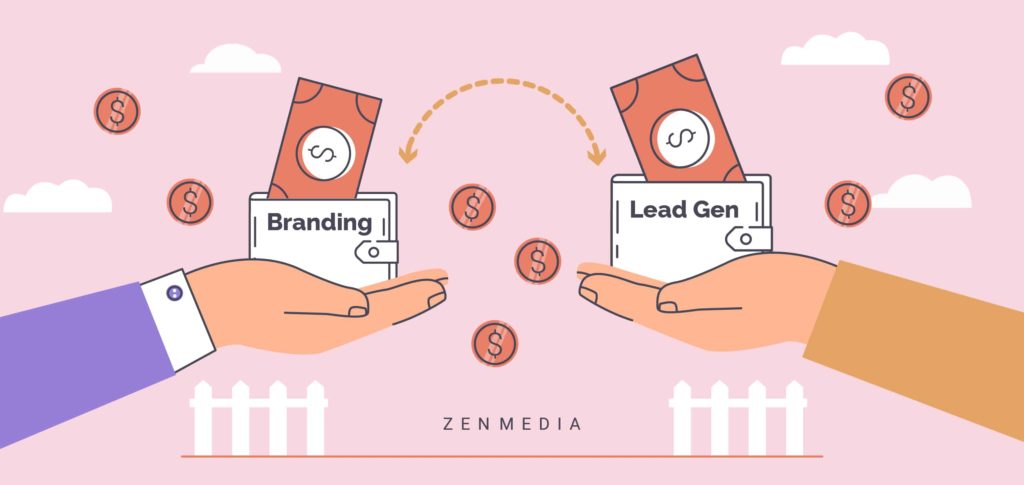CMOs have a delicate balance they have to maintain.
They need to show the value of their marketing department’s work in hard numbers while continuing to invest in the activities that actually drive long-term growth—which, incidentally, are much harder to quantify.
This explains why so much of the typical B2B marketing budget is weighted far more toward lead generation than branding.
In fact, according to recent research by LinkedIn, in 2016, 72% of marketing dollars were going toward lead generation—that’s an increase from 47% in 2007.
But is this the best use of brands’ marketing budgets?
Spoiler alert: Nope.
Let’s look more closely.
Why are brands spending so much of their B2B marketing budgets on lead generation?
First, let’s look at how this situation came to pass. Why are B2B marketing budgets weighted so heavily toward lead generation?
The answer is a simple one: because brands, like people, tend to value the concrete, short-term results that lead gen activities bring in over the less quantifiable but ultimately more valuable long-term results that branding achieves.
Let’s consider an example from the early pandemic. In spring 2020, countless brands (including those we worked with) were terrified because the trade shows they typically relied on for heavy lead gen were canceled. They didn’t know how they were going to make up for that lost opportunity.
So our team asked those same marketers why they did those trade shows in the first place. Interestingly, the answers they gave didn’t have to do with how effective the events were. Instead, our clients were doing the trade shows because that’s what they’d always done. The method worked well enough to keep doing them—and that was all.
Now, we had other clients who were willing to pivot and try something new during that same period. One of them, a client in the restaurant technology space, had both their major trade shows canceled in 2020. So they shifted to a completely owned and earned PR strategy—in other words, a branding campaign.
They landed 1500 leads—but even more importantly, they drastically increased their qualified leads. That’s where branding campaigns excel.
Over time, the gains your B2B gets from branding campaigns will outshine those that come in from lead gen every time. You have to be willing (or able to convince your CFO) to wait a little longer for them to build.
What are the benefits of B2B branding campaigns over B2B lead gen campaigns?
Branding matters in any business, but it matters even more for B2Bs, where reputation and expertise are critical.
Consider this example. Say you’ve got a great lead magnet that’s pulling in hundreds of prospects weekly. They download it, read it, and most of them like what they see.
Naturally, they want to learn more about your brand. They visit your website, check out your social media, search you online, and—they can’t determine what you’re about. What sets you apart from your competitors? Where’s that consistent brand voice? Where’s your engagement with others across the industry? Where are the earned media mentions that help prove you’re the real deal?
Here’s where branding comes in. Without branding, those leads you’re collecting likely won’t stick around, which means your business can’t grow.
The specific benefits of B2B branding campaigns include:
- Building reputation
- Increasing client and prospect trust
- Attracting purpose-driven employees
- Attracting Millennial and Gen Z B2B buyers, who are most likely to make buying choices based on values and social responsibility
- Increasing client loyalty
That last point, increasing client loyalty, is key: Branding can not only help bring leads into your client base, but it can also help keep them there. Creating a positive and streamlined brand experience, one that’s consistent throughout the entire sales funnel, can work heavily in your favor in terms of client retention.
That’s because B2B buyers, just like the rest of us, have grown used to interacting with B2C companies, like Netflix and Lyft, that create highly personalized experiences from start to finish. So it stands to reason that they expect something similar from the B2B companies with whom they work.
What’s the right balance to strike between B2B branding and B2B lead gen?
Does this mean B2Bs should skimp out on lead gen activities and put all their marketing budget toward branding?
No—but it does mean that they should start weighting those B2B marketing budgets more toward branding and less toward lead gen.
LinkedIn’s research shows that the right budgetary balance is 60-40: 60% branding, 40% lead gen. That will give you the room you need to develop and execute some strong branding campaigns while still devoting resources to lead gen—just fewer than you probably did before.
Bonus points to your B2B marketing team if they can integrate branding with lead gen somehow. This is the kind of holistic approach that can truly move the needle. By combining paid ads with B2B PR, social media with B2B influencer marketing—and always ensuring a solid content strategy underpins everything—you can achieve better results than branding or lead gen could in a silo.
Need some help getting your branding off the ground? Give us a call!




